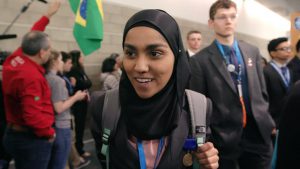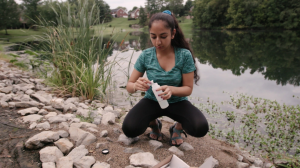Received by a standing ovation from the entire Mountainfilm audience, Science Fair pulls at heartstrings and inspires hope in all ages. Instantly loved by those in big cities and small towns alike after its 2018 premiere at the Sundance Film Festival, Science Fair won the first ever Festival Favorite Award. What had started off as a film on the science fair and the journey to it became something deeper when the directors realized that their subjects were from communities that were under attack–specifically, women and immigrants.
During the entire 90 minutes of the film, viewers’ eyes are glued to the screen and maybe just a bit damp as the young subjects from around the world prepare for ISEF (the International Science and Engineering Fair). Directed by Cristina Constantini and Darren Foster, the film focuses on nine high school prodigies as they navigate through tough competition, struggle for recognition, and of course, battle with hormones.

As most competitive documentaries go, there is a range of subjects to view and experience. Through the interviews with the students, teachers, and families, and the B-roll consisting of their lives leading up to and in the competition, the personalities of the ambitious and eccentric students stand out. Through their stories, the audience can see an elevated sort of slice-of-life with a sprinkle of envy at the intelligence level of the contestants.
Meant to inspire all, the stories of Myllena and Gabriel, Kashfia, and Robbie are ones that stand out most of all. In Myllena and Gabriel’s stories, there are shots of the small Brazilian town with little resources and even less education, with interviews with the two teachers at the school and Myllena’s family. Here, you learn how nearly impossible it is that these two kids were learning and working on curing the disease known as the Zika virus. Kashfia is a shy Muslim girl, living in a small South Dakota town that focuses on their mediocre (at best) sports teams and fail to acknowledge anything else. Following Kashfia on a tour of her school, she shows all the trophy cases for athletic awards while she talks about getting the football coach to be her faculty advisor, and the lack of recognition she got for an international award in a different science fair.
Fan favorite Robbie, meanwhile, is the perfect example of the awkward nerd in school, flowery collared shirts and all. Although he did poorly grade-wise, Robbie is a computer genius and made a graphing calculator output Shakespearean insults and a program that writes original raps of Kanye West nature.

As a former ISEF participant, Constantini had the in on the competition and conducted substantial research on the powerhouse schools and other likely winners to find ideal subjects for her film. For Ivo, the German aeronautic revolutionary high schooler, Constantini decided to work backwards and flew back to get his back story after the competition.

Science Fair asks the audience to rethink winners, showing the trend of white and male in past ISEFs, and contrasting it with last year’s mixed group of winners. So, what are we going to do to support our next generation? How will we as a society, help embrace science and engineering to help us and carry us forward? Science Fair–and the ambitious, intelligent contestants it features–shows us what a future might be.

Recent Comments